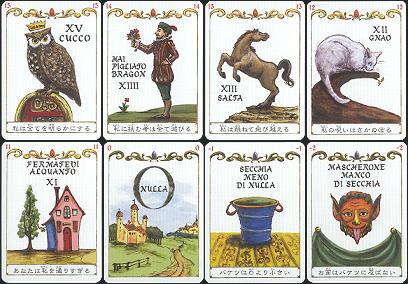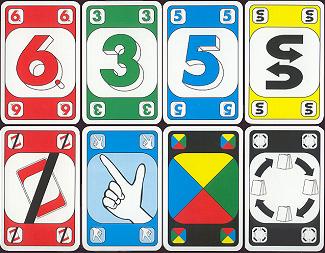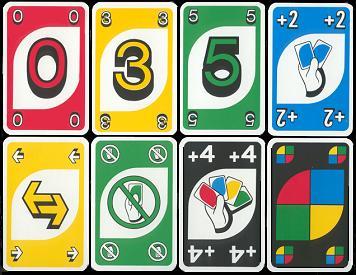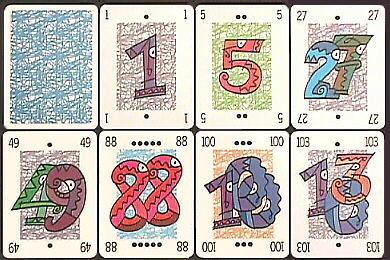various games - part 2
CUCKOO
ROOK
LEXICON
SOLO and UNO
WHOT! and GET OUT!
DUMMY
TAKE 6 ~ 6 NIMMT! ~ 6 PREND! ~ SEI
go to part 1
DOMINO · OLD MAID · SNAP · HAPPY FAMILIES · QUARTETT
a credit to Bo Bernville for his precious information about
the Kille deck, and one to Ingo Werner for his feedback about Quartett
CUCKOO
Cuckoo is an old group of games, played since the 16th-17th centuries in many
European countries. The first rules were likely devised in Italy, from where they crossed central Europe reaching
Scandinavia; today only in few countries (northern Italy, Sweden, Norway) traditional decks are still in use for playing
Cuckoo games.
These particular decks consist of illustrations of various subjects, one of which is usually a cuckoo bird (whence the name of the game) and a series of values (1 to 10, or 1 to 12, according to the country) either expressed with numerals or with pips.
Each subject is repeated twice.
Some subjects can be found more or less unchanged in different versions of the deck, and also some of the ones apparently unique to one country reveal connections to the ones used elsewhere; the taste and the local culture indeed exerted a certain influence on these cards, but despite the differences, the common origin of the group is still rather evident.
Also the number of cards slightly differs from country to country.
John McLeod's
Cuckoo
Page has full rules for the game, while more historical information about these decks can be found in Bo Bernville's
Kille Page.

Cuccù deck by Masenghini, Italy; from the left:
(top row) Cuckoo (15), 'Big Pants' (14), Horse (13), Cat (12), Inn (11),
(bottom row) Lion, Fool, Bucket, 'Nothing' and Mask |
CUCCÙ (Italy)
The Italian version, shown on the left, is called Cuccù or Cucco (archaic), meaning "cuckoo". It is very likely the oldest of the group. It consists of 40 cards, with interesting old-looking
illustrations in colour. Some of the subjects feature their own name, and a few of them also bear amusing comments, referring to the action of the subject in play. The highest card is the cuckoo, whose picture though features an owl, which scores 15 points. The following ones, in decreasing order, show a funny character called Bragon (literally "Big Pants") with a comment saying "you found Bragon", a horse with the word Salta ("jump"), a cat crying Gnao ("meow"), and a an inn whose comment is "stop for a while".
|
The remaining picture cards score no points; they feature a fool or jester, similar to the joker of Bridge cards, a rampant lion holding a shield, a bucket (Secchia, worth "less than nothing"), and a grotesque face (Mascherone).
The number cards run from 1 to 10, showing their value in roman numerals (no pips). But a further card
featuring a yellow disk says Nulla ("nothing"), equals to value 0.
In recent years, Cuccù has gained some popularity in Japan too, especially among card collectors and historians. |

card no. 8 |

the Japanese edition of Cuccù cards |
For some time Italian imported decks have been used for playing the game; then, a local team of researchers decided to produce an edition of their own (left), based on the old design, but drawn by a Japanese artist. Besides the traditional subjects, including the amusing comments - left in Italian! - each card also features the number of points it is worth, in the upper corners, and a short caption in Japanese at the base. The number cards, unlike the original ones, are spelt in Western numerals. |
This first edition was then followed by a further variant, with identical subjects, but with number cards featuring different background views. |

two number cards from the first edition (left) and from the second one |
KILLE (Sweden)
The Swedish version, shown on the right, is called Kille, a word which does not have a specific meaning. The deck consists of 42 cards, i.e. one couple of subjects more than the Italian version. Also Kille cards feature old-looking illustrations in traditional fashion, printed in monochrome brown or sepia. All the picture subjects bear their own name, but the points they score are not stated.
The highest card in rank is Harlequin (Harlekin, also called Kille, whence the name of the game. The cuckoo (Kuku) comes next in rank, marking a difference with the Italian game, but the overall series of subjects shows many common features (see below). The others are a hussar (Husar), a boar (Husu), a cavalier (Kavall), an inn (Värdshus). |

Kille deck by Öbergs (Sweden); from the left:
(top row) 5, grotesque face, inn, cavalier,
boar, hussar, cuckoo and Harlequin |
The non-scoring subjects are a wreath (
Krans), a flower vase (
Blompottan) and a personage with a funny face (
Blaren).

replica of an early Kille deck, by Offason (Sweden) |
The number cards run from 1 to 12, showing their value by means of pips in the shape of a heraldic fleur-de-lys (a lily); in modern editions these cards also have small numeral indices in the corners.
The many similarities with Italy's Cuccù deck include the cuckoo subject (both packs), the cavalier (a horse in the Italian version, but note the similar names Kavall / Cavallo), the inn (also with a similar perspective of the view in both versions), and the grotesque
face. Also the hussar may be related with "Big Pants", since both personages are featured in a standing attitude, and both of them rank between the cuckoo and the cavalier-horse. |
Another variety belonging to this group is the Norwegian
Gnav deck. This one consists of 42 cards, as the Swedish version, but the name of the game is clearly related to the cat's cry (
Gnao) belonging to the Italian version: in fact a cat, which does not belong to the Swedish version, is included among the illustrated subjects of the
Gnav deck. The following table compares the three versions. For the sake of an easier comparison, instead of listing the subjects according to their relevant ranking (which slightly differs from country to country), all those showing analogies share the same column; only the last illustrated subject of each series does not seem to be comparable.
| CUCCÙ | Cuckoo | 'Big Pants' | Horse | Cat | Inn | Fool | Bucket | Funny Face | Lion | X to I | 0 |
|---|
| KILLE | Cuckoo | Hussar | Horse | Cat | Inn | Harlequin | Flowerpot | Funny Face | Wreath | 12 to 1 | |
|---|
| GNAV | Cuckoo | Dragoon | Horse | Cat | House | Fool | Pot |
| Owl | 12 to 1 | 0 |
|---|
The subject that in the Swedish deck corresponds to the Italian and Norwegian fool is likely Harlequin, despite this subject is the highest in rank of the
Kille deck. Also the
Blaren (funny face), who wears a hat with rattles and bells tied to it, may be consistent with the jester, but since the subject focuses on the personage's large face, rather than showing his figure in whole, the Italian
Mascherone (funny face, missing in the Norwegian version) seems to make a better match.
Once also the old game of
Hexenspiel ("witches game") belonged to this group; it was played in Austria and in southern Germany. Very similar in structure to the aforesaid versions, it also counted among its subjects three unique ones, the Sausage, the Dish and the Jug. Regretfully, the game died out before the turn of the 20th century, and so did its cards.
The structure of Cuckoo games may be raher different, even within the same country.
In some of them, each player is dealt one card which, according to some rules, can be swapped with a neighbour's card if, in doing so, the player hopes to pick a higher value than the one he gives away: at the end of each round, who remains with the lowest value in hand is the loser.
In other games, instead, at the beginning of each round one card is randomly turned face up, thus becoming the trump, and tricks are played with the aim of collecting as many scoring cards as possible.
ROOK
Rook is a game played in North America, especially in the north-east of the
USA and some areas of Canada. The deck is made of 57 cards, which are divided into four suits
representing colours: Red, Yellow, Green and Black. Each suit has fourteen cards, from 1 to
14 (as in tarots); one Rook card featuring this bird, more or less like a Joker, completes the
pack.
(thanks to Stuardt T.Clarke for kindly
providing me with this deck)

Rook deck, printed in Belgium for Parker Bros., U.S.A.
The deck was devised in the 1930s, specifically for this game; curiously, the author, George S. Parker, was to become the founder of a famous company that produces cards and games.
There are several variants of
Rook rules, most of which are based on tricks (i.e. single turns in which one card is played by each player, and who plays the most valuable one takes the group), after having chosen which colour will be the hand's trump suit.
QUITTLI
alternative names:
QUITLI, QUITLOK, KVITLECH, KVITLACH

Quittli cards by Piatnik (Austria) |
Quittli is a game known under different names, as it is played especially during the festivity of Chanukah by Jewish communities from central and eastern Europe: therefore, it is found in different countries, but it is not particularly popular. Actually, this is a gambling game, and the use of special cards, featuring only large numbers without any illustration, is an expedient to bypass a religious ban. The only peculiar detail is that the the 2s and 11s are surrounded by a decorated frame. The deck consists of 24 subjects, i.e. two series running from 1 to 12.
Different variants of Quittli are known, all of which based on a structure reminiscent of Baccarat: the participants receive one card face down, and play individually against the banker; they may ask for another one, trying to get as close as possible to a total of 21, without exceeding this score, otherwise they lose. |
LEXICON AND ITS VARIANTS
Lexicon is the predecessor of modern Scrabble: instead of tiles it had
cards, and no board was used to spell words, but the basic rules were the same: the player had
to create the longest possible word by using the cards he held and those already on the table,
earning points according to the value of each letter (shown in the corners).
A "Lexicon" card acted as a joker.
The deck used to be manufactured in several European countries. The edition shown in this page was made by Waddingtons (UK). These decks have long since turned obsolete; however, from time to time similar versions of the game appear again, with different names. |

a Lexicon deck
by Waddingtons (UK), c.1935-40 |

Parolettere by Modiano (Italy), issued in 2006 |
One of these variants has been very recently produced by Modiano (Italy), called Parolettere or Scala Verbale. The deck consists of 52 cards, 22 of which feature vowels, coloured in yellow, while the remaining ones are consonants, in green. Unlike Lexicon, these cards have no numeral value marked on them, and no 'joker' card belongs to the deck.
The structure of the game is reversed: the cards are arranged on the table as a 5 x 5 square, and the players in turn remove the letters that form words (the gaps are then filled with the remaining cards left unplayed). Who takes more is the winner. |
SOLO AND UNO DECKS
Solo and Uno are family games played in many countries; their rules are very
similar, and the decks used are very similar too.

Solo deck
(by Dal Negro, Italy) |
Both games are a modern version of Dernier,
which is played with a standard Bridge deck.
These packs contain 112 and 108 cards, respectively. Suits are colours (green, blue, red and
yellow), each of which has values running from 1 to 9 (Uno decks have a 0 card too), plus
a number of special picture cards featuring hands, arrows, four colours, and so on.
The exact rules are too complicated to be explained, but the main goal for each player is to get
rid of all the cards held in hand before any of his opponents does so; each participant in turn
plays one of his cards, trying to match either the colour or the value of the subject discarded by
the previous player.
|
Picture cards cause particular events, such as to invert the direction of the players' turn,
or to force a player to add more cards to the ones he already holds, or to force an opponent
to exchange cards, etc.
The first player who remains with no cards is the winner of the round, and his opponents count
the total points still held in hand (picture cards have specific values).
Since the names of the two games are registered, different companies around the world manufacture
identical decks.
|

Uno deck
(by Spear's Games, UK) |
WHOT! and GET OUT!

Whot! deck
(by Waddingtons, U.K.)
Basically, the player's goal is to try and get rid of his cards before his opponents do so,
by discarding them one by one, matching the shape or number of the card previously played.
|
Played in Britain since the 1950's, Whot! (or Get Out! in some
versions) is based on the same principle as Solo and Uno: the deck is divided
into five suits, which are identifiable by different shapes. Cards are numbered with a
progressive numeral, from 1 to 14, though some values are missing according to the suit; a
number of additional cards named after the game ("Whot" or "Get Out" cards), usually three
or four per deck, raise the total number of cards in the pack to 52 or 53.

Get Out! deck (China, manufacturer not stated),
featuring chimps inside the shapes, and PG Tips
advertisement on the back
|
DUMMY

Dummy deck by Dal Negro (Italy);
the only values are 3, 4, 5, 6 and 7 |
Dummy is a very recent game (copyrighted in 1998), for which the
Italian manufacturer Dal Negro has produced a pack of 106 fancy cards, featuring smiley
faces instead of pips. There are no suits, and values run from 3 to 7.
The game is fast, and easy to learn. At first, all the cards are dealt; each player
then discards one in turn and, according to its value, he places it face up on one
of five central piles: each pile can hold only cards of one specific value. When any of the
piles reaches the same amount of cards as its number (i.e. three cards for the pile
holding 3s, or five cards for the pile holding 5s, etc.), it is taken by the player who
has "completed" it, and a new pile for that value is started by the following opponents.
The player who by the end of the round has captured more cards is the winner.
|
TAKE 6
Take 6 is a recent game, first copyrighted in Germany in 1994 with the original
name 6 Nimmt ! (the same name is also used in the Netherlands), while in France it was called
6 Prend !, and Sei in Italy; it was awarded "Game of the Year".
Each card of the deck features a fancy number, from 1 to 104 (therefore, each subject is
different from the others).
Above the number is one or more black dots, which in the game represent "penalty
points".
Take 6 is a trick game, in which participants play in turn one of their cards;
according to the value, the card has to match with other rows of cards already played,
in the center of the table. When a player lays the 6th card in a row, he has
to take all the five cards before his, and place them in front of him in a "penalty pile".
At the end of each round, each player will count how many black dots he has in his "penalty
pile"; the game ends when one of the players has reached a total of 66 penalty points.
|

Dal Negro's version of the game (for Italy);
each of the cards features a different fancy number |
OTHER GALLERIES




















or back to

INTRODUCTION
AND HISTORY
|

MULTI-LANGUAGE
GLOSSARY |

THE FOOL &
THE JOKER |

INDEX
TABLE |

REGIONAL
GAMES |

PLAYING CARD
LINKS |